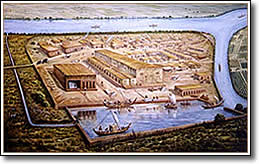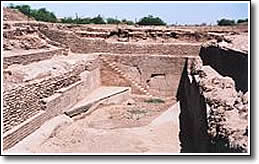| BesidesWork |  |
Home / BesidesWork /
|
|
|
 |
| Fascinating India |
| The Fascinating Art of Water Management in Ancient India |
| Author : | thedesk |
| Institute : | |
| Posting Date : | 08/09/08 |



|
|
|
| Total 59 vote(s). |  | |
|
|
|
|
|
When you progress forward in a manner like the Indian economy is doing currently, there comes a time when stopping for a moment to understand the glorious systems of the past converts the uncertain probability of success of similar future plans into realistic possibilities. In the case of India, the fascinating past of water management and conservation reminds us how naturally abundant we are and what magnificent riches can be reaped through successful management of these resources.
|
|
|
"India chose her places of pilgrimages on the top of hills and mountains, by the side of the holy rivers, in the heart of forests and by the shores of the ocean, which along with the sky, is our nearest visible symbol of the vast, the boundless," said Rabindranath Tagore.
If the snow-capped mountains to the north are the beautiful ivory crown that this country wears and the blue oceans around its coast are sheets of velvety calm, the rivers and lakes then are the arteries in its body with the necessary fuel that help the country survive and grow by providing a supply of water resources, transportation and hydroelectric power. India is also a land of many seasons. The monsoons provide us with the resource for water harvesting and storing.
India was a cradle of civilization in the ancient world. Her history therefore opens up a cupboard that surprises, enriches and fascinates our minds - all at once. The past also tells us how the natural resources were gainfully utilised earlier and how they continue to be our greatest allies in meeting the modern day needs of living.
India has nearly 4% of the world's water resources with the largest volume of river flow and rainfall at 2,000 million cubic meters and 4,500 millimetres respectively - more than that of the entire continent of Europe put together. Though a medley of rivers crisscross the belly of the country and possess a potential to be interlinked gainfully, which in turn can attend to the problems of inadequacy in water resource availability in India, it hasn’t been attempted yet. In recent years though, the National Water Development Agency (NWDA) has come up with a proposal for a set of inter-basin transfer canals. Interlinking of rivers can increase food production; water availability and productivity increase in the presently irrigated areas.
The history of water management in India goes back a long way, before some civilizations had even begun settling down as organised societies. Mohenjodaro and Harappa were old yet developed cities in the ancient times. These cities were well-organised and built of brick and stone. The drainage systems, wells and water storage systems were ahead of its time. These organised systems set them apart from all other ancient civilisations. It is when we take a look at the ancient water harvesting systems that such an activity not only appears doable, but stands out as a phenomenon to be marvelled at.
Most of these civilizations settled down on the banks of a water body like a river or a sea since this ensured a constant supply of water for their needs. Water was necessary for cultivation and irrigation of crops. Water transport was used significantly, and waterways were an important source of trade and commerce.
Water tanks, canals and bunds were built 5000 years ago in Harappa and Mohenjodaro. Every village in the Sindhu-Saraswati basin (where these civilizations existed) had a water storage tank. Some of these structures still stand today as a proof of these prosperous times. In these cities, all houses, including those that were at the periphery were linked to the respective city’s central drainage network.
The Indus Valley Civilization that flourished along the banks of the river Indus and other parts of western and northern India had the most well developed urban water supply and sewage systems in the world. This civilization maintained high standards of hygiene and sanitation, and had enclosed drains that were laid beneath the streets of the towns.
About 80 kilometres from Ahmedabad in Gujarat stands the ancient Harappan town of Lothal. This town has a landscape that is sun burnt, its soil is cracked and parched, and it has little natural wealth. Lothal, therefore, not wrongly means the mound of the dead in Gujarati. But here is the real surprise: 4,000 years ago, this very city was a thriving port, and was counted among the principal centres of the Indus Valley Civilisation.

Image 1: Lothal Water Systems – A simulated Picture
Apart from implementing sophisticated environmental design and town planning concepts during those times, there is tangible evidence that Lothal’s residents had built water transport and a fascinating terraquaculture system - which means integrated land and water use practices. Such systems are in fact common to most traditional societies, but the one in Lothal seems to be quite advanced.
Terraquaculture in Lothal was based on lunar farming cycles and made effective use of seasonal flooding. The system involved an integration of the city’s infrastructure with its ecosystem. Waterways were created for transport within Lothal; there were canals for irrigation and aquifer wells for domestic water supplies. And if this doesn’t astonish you, read this: Lothal’s residents developed intricate drainage systems and sophisticated brick cisterns for cleaning and purifying water. These were equipped with aeration chambers and lime and charcoal filters. Mining, manufacturing and other industries were located near waterways and linked through networks of river ports, canals, shipyards and warehouses. The people in these cities knew the results of integrating water management with industrial life.
Yet another excellent example is the well-planned Harappan city of Dholavira, in Gujarat. The Archaeological Survey of India excavated this city in 1989. People lived here well before 3000 B.C. and continued for more than a millennium. This long history provides important information about the times and development of this ancient civilization. One of the unique features of Dholavira is the sophisticated water conservation system of channels and reservoirs, the earliest found anywhere in the world and completely built out of stone. They were used for storing the fresh water brought by rains or to store the water diverted from a nearby rivulet. This probably was forced upon them by the desert climate and dry conditions of Kutch, where several years would pass without any rains.

Image 2: Dholavira
Water conservation was an issue that was addressed by the people living in this ancient society. Despite the presence of water systems, water conservation was followed religiously. In ancient times, houses in parts of Rajasthan would have a rooftop water harvesting system. Though rains are scarce in Rajasthan, rainwater from these rooftops would trickle down and flow into underground tanks.
Then there is a place near Pune, called Naneghat, which has one of the world’s oldest water harvesting systems. A number of tanks were made out of the rocks for providing drinking water to travellers along this ancient trade route. This area had rock-cut cisterns, ponds, tanks and wells that were used for water harvesting.
The amazing aspect is that the developments were not confined to one particular place. There was tremendous development across the region. Underground earthen pipes constructed many years ago maintained the flow of water to distant places, some of them are still in place at Burhanpur (Madhya Pradesh), Golconda (Andhra Pradesh), Bijapur in Karnataka, and Aurangabad in Maharashtra.
Water purification was an ancient practice in a land where contamination could be rapid. In ancient India brass vessels were considered good for storing drinking water, which now has been corroborated scientifically. Microbiologists affirm that water stored in brass containers can help combat many water-borne diseases.
Varahmihira wrote in the Brihat Samhita about the purification of ground water in the wells. In the treatise of the Indian physician Sushruta, he wrote that muddy water could be purified with herbs and natural substances. He recommended the disinfection of contaminated water by exposing it to the sun or immersing red-hot iron or hot sand in it.
The Chandragiri Fort in Andhra Pradesh had 2 rainwater-harvesting systems in the 10th century. One was used for creating water self-sufficiency for its residents, considering the unpredictability of wars. The other structure provided water to the fort's moat. Both the fort and the moat are in a dilapidated condition today. However the harvesting system is still functional. There is a granite hill that allows almost all the rainwater to collect in a 2.6-million gallon capacity open reservoir carved at the foot of the hill.
A great deal of scientific thought and purpose went into its construction. There is an enclosure of trees to minimize evaporation, and the lotus plants in the reservoir are said to have a purifying effect on water. The water is pure and un-treated which is good for human consumption. In case of the Chandragiri Fort its architects rightly adopted a conservation method that involved catching water from steep hill slopes that ensured purity. This is because the extreme slope of the land did not allow habitation to grow around it, unlike in plains.
At Inamgaon in Maharashtra, excavations have revealed irrigation channels and systems of water harvesting and water distribution dating back to 1600 BC. The rock pillar inscription of Skanda Gupta (456 AD) at Junagadh describes the repairs of Sudarshan Lake built 300 years prior. The Kanheri caves (1st century AD) and other Buddhist caves have a system of water harnessing and distribution, which are serviceable today. Apart from these, thousands of other water-harvesting systems existed all over the country and were maintained by rulers and the residents.
In recent times too, there have been extraordinary individuals who realised the need to use the water systems followed in ancient India. The voices have however been few and far between. Visvesvarayya was one such engineer in post independence India who felt the country needed to take advantage of its water resources. He designed a system of automatic weir water floodgates, which were first installed in 1903, at the Khadakvasla reservoir near Pune.. These gates were used to lift the flood supply level of storage in the reservoir to the highest level likely to be attained by its flood, without causing any damage to the dam. He also designed a flood protection system to protect the city of Hyderabad from floods. Though Visvesvarayya was the architect of water management in modern India, he took inspiration from the ancient civilizations.
A report on water harnessing in India in ancient times refutes the claim of water scarcity in this country. Water can be harnessed through rainwater harvesting, recycling effluent water and creation of a viable network of rivers and distributaries. The report criticizes the wastage of water and censures Chennai for alone releasing nearly 2,54,880 cubic litres of water to the sea every year which is more than its annual requirement of 2,46, 375 cubic litres (Source: http://www.nerve.in/news:253500127007). Over the last 200 years, the country has lost much of its big and small traditional water harvesting sources. Delhi, the country's capital for instance, has allowed nearly 274 stepwells, built during the Mughal rule, to dry up rapidly.
Pamela Gales Malhotra of the Safe Animal Initiative (SAI) Sanctuary, an organization working for the protection of wildlife in Karnataka feels that water is at the root of all forms of poverty in the world. "Protecting water sources is vital to conservation of environment and species. We are witnessing the sixth wave of species extinction now and are losing species 1,000 times faster than before," Malhotra says.
When you progress forward in a manner like the Indian economy is doing currently, there comes a time when stopping for a moment to understand the glorious systems of the past converts the uncertain probability of success of similar future plans into realistic possibilities. In the case of India, the fascinating past of water management and conservation reminds us how naturally abundant we are and what magnificent riches can be reaped through successful management of these resources.
Taking a leaf out of such a fascinating past brings a sliver of hope that this country can again use its rivers, lakes, waterways, monsoons, drainage systems to address the infrastructure, irrigation, power and water storage needs better. The way it once did thousands of years ago.
Sources:
http://proxied.changemakers.net/journal/03july/chandragiri.cfm
http://www.boloji.com/environment/162.htm
http://www.trinet.in/modules/news/article.php?storyid=910
http://www.indiatogether.org/opinions/guest/sriramv0802-1.htm
http://www.downtoearth.org.in/full6.asp?foldername=20040930&filename=news&sec_id=50&sid=56
http://pubweb.cc.u-tokai.ac.jp/indus/english/2_4_02.html
, |
| Total 59 vote(s). |  | |
|
|
|
|
|
 | Messages/Opinions |
|
|
| | No messages yet! Be the first one to post a message here. |
|
Click Here to login and post message
|
| Indian Alumni and Students from the following Indian and Global Institutes are invited to be members of 6bridges.com: |
| |
| India |
| Business & Accounting Institutes : FMS, ICAI, IIFT, IIM(A), IIM(B), IIM(C), IIM(I), IIM(K), IIM(L), IRMA(Anand), ISB, JBIMS, MDI(Gurgaon), NITIE, NMIMS, SJMSOM(IIT Bombay), SPJIMR, TISS, XIMB, XLRI |
| Technology Institutes : BIT(Mesra), BITS(Pilani), COE-Guindy(Anna Univ.), DCE, IISc, IIT(B), IIT(M), IIT(D), IIT(G), IIT(K), IIT(Kgp),IIT(Roorkee), ISI(Kolkatta), ISM (Dhanbad), IT-BHU, Jadavpur Univ., National Institutes of Technology(RECs), PSG(Coimbatore), RVCE(Bangalore), VJTI |
| |
| Global |
| Business, Technology & Accounting Universities/Institutes : AGSM(Sydney), AIM(Manila), Caltech, Carnegie Mellon, Columbia, Cornell, Dartmouth, Duke, Georgia Tech, Harvard, ICAEW(UK), IMD(Switzerland), INSEAD, Judge(Cambridge), London Business School, Manchester, Melbourne Business School, Michigan, MIT, Northwestern, NYU, Princeton, Purdue, Queen's(Canada), Said(Oxford), Stanford, U.Chicago, U.Penn, UC Berkeley, UCLA, Univ. of Illinois-Urbana, Univ. of Southern California, Univ. of Virginia, Warwick, Yale |
|
|

















